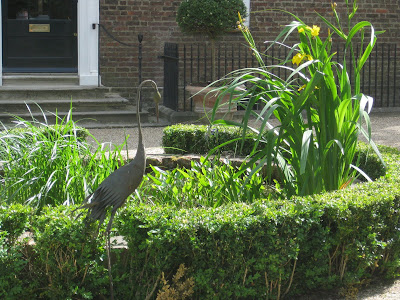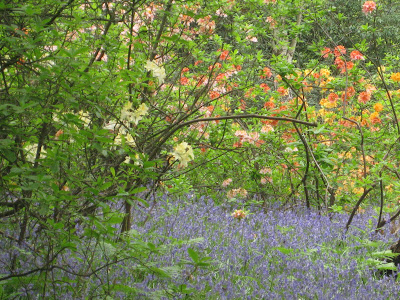It was an ambitious plan but it worked.
I visit many gardens and when
Ham Open Gardens 2011 opened lots of gardens scattered around Ham Common, just a few minutes walk from where I live, then I leaped at the chance to go to some more.
First up were the extensive grounds of the Cassel Hospital.
The plot is enormous and this picture can only suggest some of the scale. This is probably around a third, or may be only a quarter, of the garden.
It's weird to think that over the fence at the far end my house is only about 20m away.
The hospital surrounded by houses but has so far kept them at bay, with one exception when a corner was given over to a block of flats a few years ago.
I hope that it remains an unclaimed open space for as long as I live here. I may not get there very often myself but open spaces like that are what define Ham for me and the wildlife appreciates it.
Moving on clockwise we come to Flax Cottage.
This is a completely different proposition. It's also a long garden but is much narrower and is busy with plants and sheds (there are at least three) and is sculptured to hide its length.
These tall plants clustered around the urn are part of that deception. They cut across your sight-line and hide the garden beyond.
But the deception is slight and the lawn snakes around the obstruction to take you to the next section and beyond.
It's a delightful garden but it looks like a lot of work so I am glad that somebody else is doing it.
The front garden to the Gate House is bit of a local landmark.
It has a prominent position next to the path from Ham Common to Ham House. It also has a very low wall so its just as well that it is so pretty.
The back garden was unknown to me before and is quite different. The front garden squeezes a lot in to a small space but the rear garden makes the most of the extra space that it has to play with.
There is a private corner just beyond the house that is accessed via these steps that are also home to a traditional collection of pots.
Taking a few steps across the avenue takes you to the other gate house which is now little more than an ornament in the garden of the much grander Avenue Lodge.
The garden here stretches alongside the avenue which gives it plenty of space to breath and be playful. One of its tricks is a cute square of paving that seems to have no purpose other than to be attractive.
There's a nice pond nearby but the paving edged it so you'll just have to guess what that looks like.
Next up is the bright white cottage next to the New Inn. Stafford Cottages used to be a terrace of three that have now pooled resources to make one incredibly cute house.
This is another garden that is very public and much admired, and rightly so.
Here order rules with precise planting between carefully laid paths. Roses are prominent, standing tall to show off their pinkness, but there are other plants and other colours that make this an idyllic cottage garden.
Behind the cottage is a infill, Bishops Road, of fairly brutal and bland houses built when the priority was to get lots of houses up quickly and not much attention was paid to what they looked like.
But an ugly house can still have an attractive garden.
The chicane in the road has given this house a larger that average garden which has been made good use of.
There is a Japanese theme complete with a little bridge though, sadly, it does not have any water to go over.
There is some water and that splashes its way down and through a metal structure that rather wishes it was a plant.
Across the road from the pub we have Sudbrook Lodge.
Here the garden is split in two by the house with a formal show garden on one side following the main road and a private family garden on the quieter side. The formal garden is under threat as the owners want to build a separate house there so it was good to see it before it goes.
The gravel path from the road coils slowly round to the side of the house where it is interrupted by a small but bustling pond.
The flamingo is a fake but the two ducks who live there happily are real enough.
The garden that everybody wanted to see was at Sudbrook Cottage. This is a little way down Ham Gate avenue, next to Ormeley Lodge.
People of my generation and older will be interested to hear that Beverley Nichols created the original garden here from a field. This was the subject of his last two gardening books, Garden Open Today and Garden Open Tomorrow.
Because of this I went with pretty high expectations which were comfortably exceeded.
The garden is a delight in many ways.
It's designed on a grand scale with several distinct areas that flow, rather than jump, from one of the other.
And within that large design there are many small details that make you stop and pay attention.
This old seat with the bold planting behind it is just one of many such examples.
There are discrete seats throughout the garden, a few strategically placed pots and a richness of plants that fills every corner. There are no barren areas but neither does it look too fussy or too planned or too clever.
One corner is sunk a little lower that the rest of the garden to create a private and quiet space.
The solitude is enhance by a low hedge between it and the main lawn. This hedge is just the right height to separate you from the rest of the garden but not too high to isolate you from it.
Seats at either end encourage you to look across the neatly clipped hedges arranged as a series of boxes. Additional plants between the hedges add new shapes and colours.
The high wall that keeps the garden very secret runs along two side. The brick looks just like brick should look, aged and brown, and a few shrubs and trees breaks the view up to prevent any chance of monotony.
The largest feature in the garden is this pond.
It's set to one side so while it commands that part of the garden that it is set in it does not dominate the garden overall. Indeed you could spend quite some time looking around and not notice it.
Water trickles in to it avoiding the more modern fashion of making as much noise as possible and this, and the stillness of the pond, helps to maintain the tranquillity and peacefulness of the garden.
And tranquillity, peace, quiet, solitude, rest are what this garden is all about.
Ham Open Gardens 2011 was a fantastic event. I saw nine local gardens that I had not seen before, some of which I had been aching to see for ages for my
Ham Photos blog where more pictures of these gardens will appear in future weeks.
Or you can indulge yourself and
see the full album on Facebook.


























































